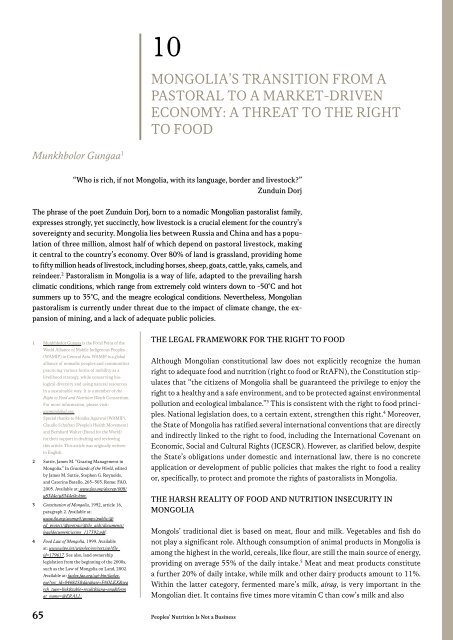RIGHT TO FOOD AND NUTRITION WATCH
1iNBHTY
1iNBHTY
Create successful ePaper yourself
Turn your PDF publications into a flip-book with our unique Google optimized e-Paper software.
10<br />
MONGOLIA’S TRANSITION FROM A<br />
PAS<strong>TO</strong>RAL <strong>TO</strong> A MARKET-DRIVEN<br />
ECONOMY: A THREAT <strong>TO</strong> THE <strong>RIGHT</strong><br />
<strong>TO</strong> <strong>FOOD</strong><br />
Munkhbolor Gungaa 1<br />
“Who is rich, if not Mongolia, with its language, border and livestock?”<br />
Zunduin Dorj<br />
The phrase of the poet Zunduin Dorj, born to a nomadic Mongolian pastoralist family,<br />
expresses strongly, yet succinctly, how livestock is a crucial element for the country’s<br />
sovereignty and security. Mongolia lies between Russia and China and has a population<br />
of three million, almost half of which depend on pastoral livestock, making<br />
it central to the country’s economy. Over 80% of land is grassland, providing home<br />
to fifty million heads of livestock, including horses, sheep, goats, cattle, yaks, camels, and<br />
reindeer. 2 Pastoralism in Mongolia is a way of life, adapted to the prevailing harsh<br />
climatic conditions, which range from extremely cold winters down to -50°C and hot<br />
summers up to 35°C, and the meagre ecological conditions. Nevertheless, Mongolian<br />
pastoralism is currently under threat due to the impact of climate change, the expansion<br />
of mining, and a lack of adequate public policies.<br />
1 Munkhbolor Gungaa is the Focal Point of the<br />
World Alliance of Mobile Indigenous Peoples<br />
(WAMIP) in Central Asia. WAMIP is a global<br />
alliance of nomadic peoples and communities<br />
practicing various forms of mobility as a<br />
liveli hood strategy, while conserving biological<br />
diversity and using natural resources<br />
in a sustainable way. It is a member of the<br />
Right to Food and Nutrition Watch Consortium.<br />
For more information, please visit:<br />
wamipglobal.org.<br />
Special thanks to Monika Agarwal (WAMIP),<br />
Claudio Schuftan (People’s Health Movement)<br />
and Bernhard Walter (Bread for the World)<br />
for their support in drafting and reviewing<br />
this article. This article was originally written<br />
in English.<br />
2 Suttie, James M. “Grazing Management in<br />
Mongolia.” In Grasslands of the World, edited<br />
by James M. Suttie, Stephen G. Reynolds,<br />
and Caterina Batello, 265–303. Rome: FAO,<br />
2005. Available at: www.fao.org/docrep/008/<br />
y8344e/y8344e0e.htm.<br />
3 Constitution of Mongolia, 1992, article 16,<br />
paragraph 2. Available at:<br />
www.ilo.org/wcmsp5/groups/public/@<br />
ed_protect/@protrav/@ilo_aids/documents/<br />
legaldocument/wcms_117392.pdf.<br />
4 Food Law of Mongolia, 1999. Available<br />
at: www.wipo.int/wipolex/en/text.jsp?file_<br />
id=179617. See also, land ownership<br />
legislation from the beginning of the 2000s,<br />
such as the Law of Mongolia on Land, 2002.<br />
Available at: faolex.fao.org/cgi-bin/faolex.<br />
exe?rec_id=046825&database=FAOLEX&sea<br />
rch_type=link&table=result&lang=eng&form<br />
at_name=@ERALL.<br />
65<br />
THE LEGAL FRAMEWORK FOR THE <strong>RIGHT</strong> <strong>TO</strong> <strong>FOOD</strong><br />
Although Mongolian constitutional law does not explicitly recognize the human<br />
right to adequate food and nutrition (right to food or RtAFN), the Constitution stipulates<br />
that “the citizens of Mongolia shall be guaranteed the privilege to enjoy the<br />
right to a healthy and a safe environment, and to be protected against environmental<br />
pollution and ecological imbalance.” 3 This is consistent with the right to food principles.<br />
National legislation does, to a certain extent, strengthen this right. 4 Moreover,<br />
the State of Mongolia has ratified several international conventions that are directly<br />
and indirectly linked to the right to food, including the International Covenant on<br />
Economic, Social and Cultural Rights (ICESCR). However, as clarified below, despite<br />
the State’s obligations under domestic and international law, there is no concrete<br />
application or development of public policies that makes the right to food a reality<br />
or, specifically, to protect and promote the rights of pastoralists in Mongolia.<br />
THE HARSH REALITY OF <strong>FOOD</strong> <strong>AND</strong> <strong>NUTRITION</strong> INSECURITY IN<br />
MONGOLIA<br />
Mongols’ traditional diet is based on meat, flour and milk. Vegetables and fish do<br />
not play a significant role. Although consumption of animal products in Mongolia is<br />
among the highest in the world, cereals, like flour, are still the main source of energy,<br />
providing on average 55% of the daily intake. 5 Meat and meat products constitute<br />
a further 20% of daily intake, while milk and other dairy products amount to 11%.<br />
Within the latter category, fermented mare’s milk, airag, is very important in the<br />
Mongolian diet. It contains five times more vitamin C than cow’s milk and also<br />
Peoples’ Nutrition Is Not a Business


